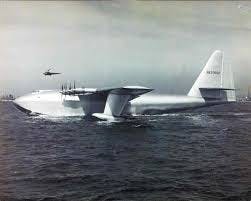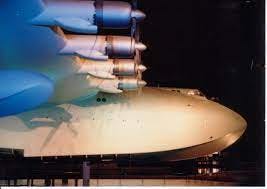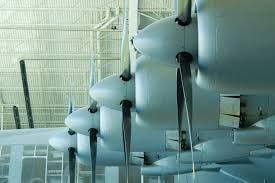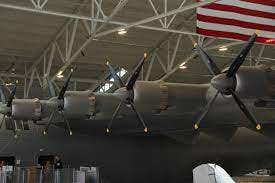The Spruce Goose (aka H-4 Hercules): a successful failure at the beginning of the jet age

Blog
In a word, World War II sucked. What with Hitler and Mussolini running rampant all over Europe, and Imperial Japan’s forces taking over a good portion of Asia and the Pacific islands, times were looking grim for the free world. A key problem was keeping the Allied warfighters in Europe supplied, since the German U-boats were sinking pretty much every supply ship anyone tried to send over. In May and June 1942 alone, 292 merchant/cargo ships were sunk by German subs (that’s almost 5 ships lost every day), and over 100 merchant ships per month were sunk during the better part of that year. The Allies were in a desperate situation, and as our grandpappy once said, desperate times call for desperate measures. So in 1942 the US War Department began working on a crazy plan to build a flying cargo ship so large that it could potentially take a good part of the supply duty away from the surface fleet. And the famously eccentric aircraft builder Howard Hughes was crazy enough to try it.
This is a brief history of the Hughes H-4 Hercules, known as the Spruce Goose.

The concept and development of the Spruce Goose
Fittingly, the original design and concept of what would become the H-4 was dreamed up by a shipbuilder, Henry J. Kaiser (no relation to our CTO, Nick Kaiser), whose company was engaged in building Liberty Ships for the war effort. Kaiser had felt the sting of severe losses of his ships to U-boats, and his shipbuilding experience would come in handy in developing the fuselage (or the “boat” portion) of the Hercules, but he didn’t have the aeronautical knowledge to make it fly. For that, Kaiser deferred to Howard Hughes and his designers.
As the project progressed, Kaiser grew frustrated with both what he saw as the War Department’s lack of prioritization of the project as well as Hughes’ perfectionism, and he eventually left the project, leaving Hughes to complete it. As the H-4 project progressed, material costs and development delays skyrocketed, and the planned 3-aircraft contract was trimmed to just a single example. The amount of money being spent was attracting negative attention, but Hughes refused to give up on the project even after the war ended.
What was the Spruce Goose made of? (Hint: neither spruce nor goose)
Well, it wasn’t actually made of spruce wood, despite the cute nickname (which Howard Hughes despised). Due to wartime shortages of aluminum and steel, as well as concerns that such a massive aircraft, if made of metal, would simply not be capable of flight, Hughes utilized a heat- and pressure-laminated birchwood/resin material called Duramold throughout the H-4’s construction. Duramold is similar to some high-performance plywoods of today, and a cylinder of Duramold was shown to be 80% stronger than a cylinder of aluminum.
Almost the whole aircraft was made from birch Duramold, with the exception of the engines, instruments, control mechanisms, and screws. The Spruce Goose’s elevator and rudder were constructed of Duramold frames covered with fabric that was then tightened and waterproofed with painted-on aircraft “dope,” in the fashion of earlier aircraft designs.

How big was the H-4 Hercules, and how much could it carry?
By the standards of the time (and even today), the Spruce Goose was gigantic. Today, the US military’s largest heavy transport airplane is the C-5 Galaxy, which measures 247.8 feet (75.53 meters) long, 65 feet (18.84 meters) high, with a wingspan of 222 feet (67.9 meters). The H-4 Hercules was 218 feet 8 inches (66.65 meters) long, 79 feet 4 inches (24.18 meters) high, with a wingspan of 320 feet and 11 inches (97.82 meters). So, the Spruce Goose was considerably larger in both height and wingspan, and nearly as long as the huge C-5.
In fact, the Spruce Goose had the greatest wingspan of any aircraft in history all the way to 2019, when Stratolaunch released their massive 6-engined, twin fuselage Roc air-launch platform for testing hypersonic missiles and aircraft. The tail section of the H-4 Hercules alone was wider (at 113 feet) than the entire wingspan of a WWII B-17 Flying Fortress bomber (103 feet 9 inches). The forces needed to move the massive control surfaces required the development of the world’s first hydraulically actuated control system on an aircraft.
As noted above, the original intent of the H-4 was as a heavy transport to fly supplies to Europe, bypassing the Nazi wolf pack submarines that were wreaking such havoc all over the Atlantic and Caribbean. The aircraft weighed 300,000 pounds (136,077 kg) empty and was designed to carry 150,000 pounds (68,038 kg) of cargo. However, Hughes envisioned its alternative use as a troop transport aircraft also, and specified a 750-passenger layout, with 3 crew members to fly the Hercules and man its formidable systems. This (theoretical) passenger capacity is impressive even by today’s standards. The Boeing 787-9 “stretch” variant of today, for example, holds only 290 passengers, and even the vaunted 747-400 in a rarely used “high density” one-class configuration could only carry a maximum of 660 passengers.

The last hurrah of piston-driven engines
As we discussed in our article on the history of supersonic air travel, both the Germans and the Brits had developed jet- and rocket-powered fighters well before the end of WWII, and it became clear that the “jet age” would soon render military and civilian piston-engined aircraft obsolete. However, at the time of the development of the Spruce Goose, reliable, powerful, and efficient turbojet or turbofan engines capable of use on an aircraft of this size hadn’t yet been developed.
The H-4 Hercules is powered by 8 (count ‘em, eight) extremely powerful, 28-cylinder Pratt & Whitney R-4360 Wasp Major supercharged radial engines, producing around 3,000 horsepower each, and driving giant 4-bladed Hamilton propellers over 17 feet in diameter. The R-4360 family was the largest-displacement internal combustion aviation engine mass-produced by the US, and a later turbocharged variant churned out 4,300 horsepower, making it the most powerful.
A 4,362.5 cubic inch (71.5 liter) displacement, 28-cylinder, 4-bank, air-cooled radial engine is itself enormous, but when mounted on the gigantic wings of the “Flying Lumberyard,” the 8 Wasps look positively tiny.
How much did the Spruce Goose cost to build?
Total development costs of the H-4 Hercules project topped $23 million, which in 1945 dollars is equivalent to over $383 million today. In our modern era where we rack up deficit spending like Uncle Frank at the casino, $383 million barely makes us look up from our smartphones, but at the time it was enough to get Howard Hughes called in front of the Senate War Investigating Committee to try to justify the egregious expense. During the war, people were okay with throwing piles of money at anything that would help the Allies save civilization, but come peacetime, someone always has to pay the proverbial piper. Hughes was adamant that he would finish the aircraft come hell or high water, and told the committee, “Now, I put the sweat of my life into this thing. I have my reputation all rolled up in it and I have stated several times that if it’s a failure, I’ll probably leave this country and never come back. And I mean it.” It turned out not to be a failure, exactly, but its success was certainly limited.

The first and only flight of the Spruce Goose
During a break in the Senate hearings, Hughes returned to California’s Long Beach area to perform taxi tests on the H-4. The committee, press, and public were very interested to see this huge beast of a flying boat move at all, and on November 2, 1947, the taxi tests began with Hughes at the controls, and hundreds of spectators watching from the beach (including movie stars Jimmy Stewart and Cary Grant). Hughes had a copilot, two flight engineers, 16 mechanics, and 2 other flight crew, along with seven invited guests from the press corps and an additional seven industry representatives aboard.
After the first two taxi runs, many reporters left the beach to file their stories, but Hughes had a surprise for the press and spectators that stuck around for the final test run of the day. After throttling up to 90 mph in the channel, Hughes pulled back on the yoke and the Hercules lifted off, remaining airborne for 26 seconds at 25 to 70 ft off the water at a speed of 135 miles per hour (217 kph) for just under a mile before settling back down into the water. (The current museum housing the Spruce Goose—more on that below—says it flew for just under half a mile, but if the speed and time aloft are correct, it works out to .975 of a mile.)
It was a surprising but not particularly spectacular flight; however, it proved enough to dissuade Hughes’ detractors from claiming his magnum opus wasn’t flight-worthy—and to many, justified his use of government funds.
Unfortunately the Spruce Goose never flew again. History.com reports, “Despite its successful maiden flight, the Spruce Goose never went into production, primarily because critics alleged that its wooden framework was insufficient to support its weight during long flights. Nevertheless, Howard Hughes, who became increasingly eccentric and withdrawn after 1950, refused to neglect what he saw as his greatest achievement in the aviation field. From 1947 until his death in 1976, he kept the Spruce Goose prototype ready for flight in an enormous, climate-controlled hangar at a cost of $1 million per year.” One source says a full-time crew of 300 workers, all sworn to secrecy, maintained the aircraft in flying condition in the hangar until 1962, when the company reduced the crew to 50 workers, and then dissolved the crew after Hughes’ death.
When the hangar lease expired in 1976, the Spruce Goose was initially planned to be broken into pieces and divided up among 8 museums (The Smithsonian wanted the cockpit), and the rest scrapped. However, The Aero Club of Southern California, the Wrather Corporation, and aviation enthusiasts around the country fought to keep the famous airplane intact, and by 1982 the H-4 was moved into a domed hangar next to the Queen Mary in Long Beach, California, and put on display to the public.
In the late 1980s the Disney Corporation bought the holdings of the Wrather Corporation and ceased funding for the Spruce Goose exhibit after 2 years, leaving its fans scrambling again to find a permanent home for the huge flying boat. The Aero Club helped save it again, and in 1992 awarded the Spruce Goose to Evergreen International Aviation and Captain Michael King Smith, who proposed to preserve and protect Hughes’ masterpiece as the central part of a new aviation museum in McMinnville, Oregon. Smith allegedly bought the Goose for a dollar, but it cost him and his corporation $7 million to transport the aircraft via barges and roads (temporarily broken into large sections and wrapped in plastic for transport) from Long Beach, California to Oregon, where it was refurbished and eventually installed in its current home at the Evergreen Aviation and Space Museum in 2001.
Who knows… maybe one day another eccentric billionaire will buy it and we can see the Spruce Goose take to the air once more.
–By Jeff Davis, Intergalactic Scribe
Sources:
https://www.evergreenmuseum.org/exhibit/the-spruce-goose/
https://www.history.com/this-day-in-history/spruce-goose-flies